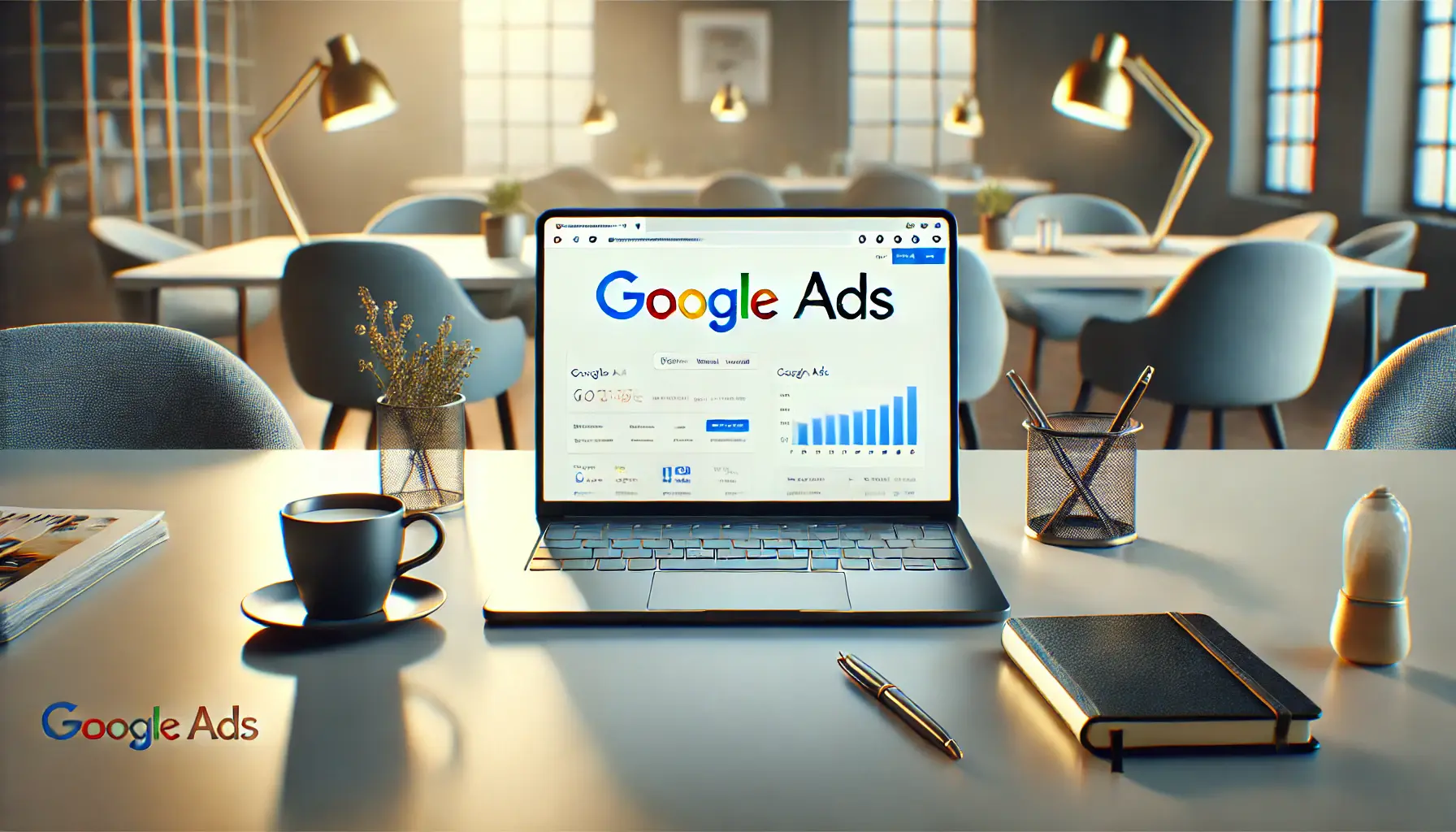Local businesses have to wrestle with unique problems in today’s competitive digital landscape.
With more people performing online searches and using mobile, being visible to potential customers in your area is now more important than ever.
One of the most powerful tools to accomplish this is Google Ads.
With its targeting capabilities and enormous reach, Google Ads can ensure that a local business not only reaches customers but also becomes an integral part of the community.
Some local businesses rely on referrals or word-of-mouth marketing and may want to expand their reach by increasing their website traffic.
Whatever their goals may be, Google Ads can help them achieve those objectives with its targeting capabilities and huge reach.
Let’s start by exploring why Google Ads is essential for local businesses.
- Why Google Ads is Vital for Local Businesses
- Setting Up Google Ads for Local Success
- Creating Successful Local Ad Campaigns
- Measuring and Optimizing Your Local Ad Campaigns
- Advanced Strategies for Local Business Google Ads
- Mastering Google Ads for Local Business Success
- Frequently Asked Questions About Google Ads for Local Businesses
Why Google Ads is Vital for Local Businesses
Every local business strives to be the go-to choice for customers in its area.
With Google Ads, you can position your business right in front of potential customers at the exact moment they’re searching for your products or services.
But what makes it such a game-changer for local businesses?
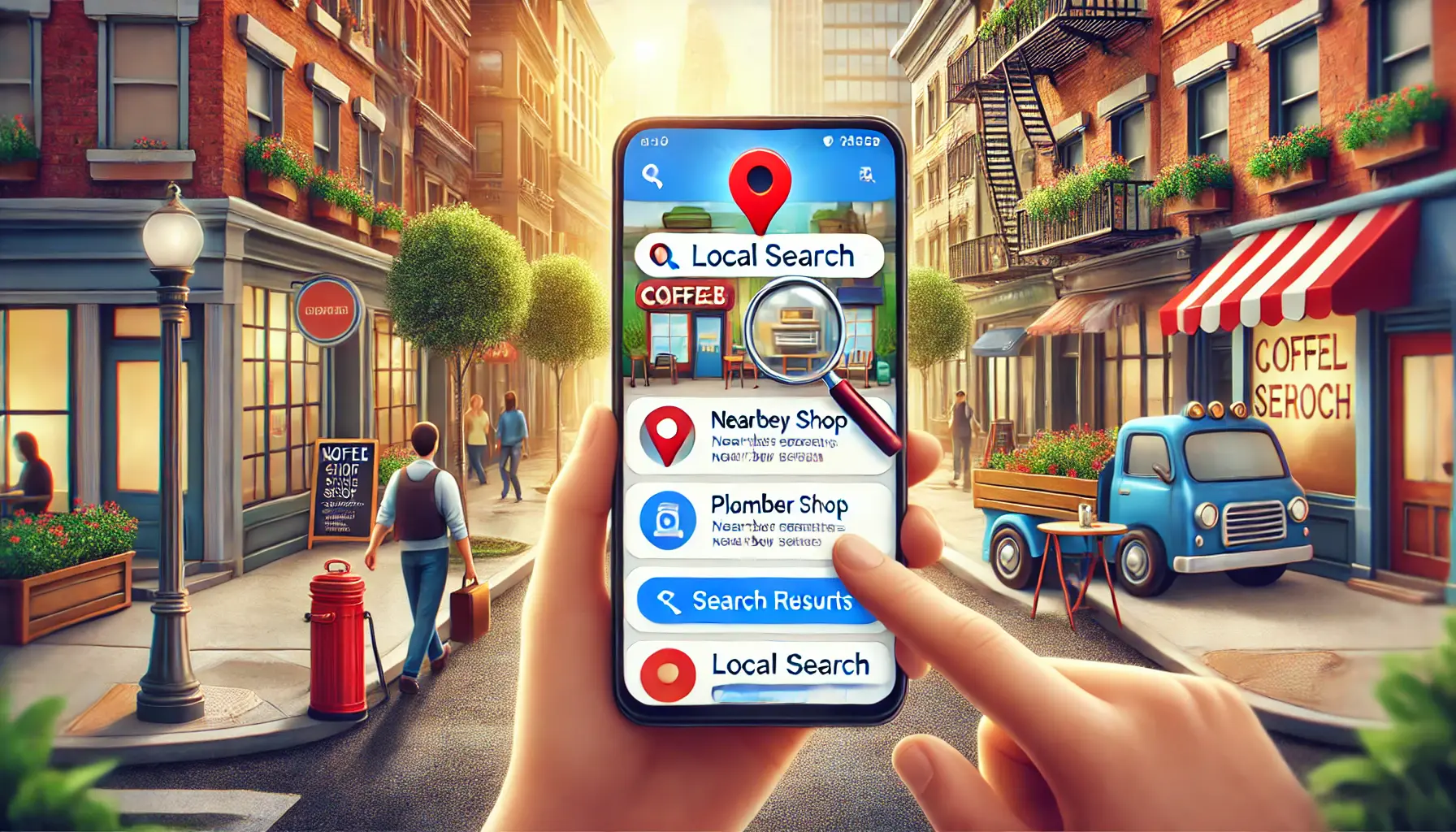
Illustration depicting a person using a smartphone to perform a local search, symbolizing the importance of local search in connecting customers with businesses.
Understanding the Role of Local Search
Local search plays an important role in how customers find businesses near them.
When people search terms such as “coffee shops near me” or “best local plumber,” they are ready to act.
Google Ads allows your business to appear at the top of these local search results, ensuring you don’t miss out on valuable leads.

Illustration showing a small business owner excited about the positive results of their Google Ads campaign, symbolizing the benefits for small businesses.
Benefits of Google Ads for Small Businesses
Google Ads offers several advantages for small businesses:
- Immediate visibility: Your ads appear instantly in search results, driving traffic quickly.
- Precise targeting: Reach specific demographics and local customers with ease.
- Measurable results: Track clicks, calls, and visits to measure your ad’s effectiveness.
- Budget flexibility: Start small and scale your campaigns as needed.

Illustration showing a local business gaining a competitive edge by attracting more customers, highlighting the benefits of effective marketing.
How Local Businesses Gain Competitive Edge
For many local businesses, standing out in a crowded market is tough.
With Google Ads, you’ll have a competitive edge because it helps you outshine the competition through better ad placement and messaging that resonates more effectively with your local audience.
A well-designed ad can make the difference between a customer choosing you or a competitor.

Illustration showing a small business owner analyzing misconceptions about Google Ads, debunking myths like expense, complexity, and inefficiency.
Common Myths About Google Ads
Some business owners hesitate to use Google Ads due to misconceptions like:
- “It’s too expensive: ” With proper budgeting and targeting, it’s affordable for any business.
- “It’s too complicated: ” The platform offers user-friendly tools for beginners.
- “It doesn’t work for small businesses: ” On the contrary, Google Ads often brings faster results for local businesses than other platforms.
By debunking these myths and understanding the platform’s true potential, you can start making informed decisions to grow your local business effectively with Google Ads.
Google Ads positions your business in front of potential customers when they are actively searching for your services, ensuring high visibility and relevance.

Illustration depicting a small business owner configuring their Google Ads campaign to achieve local success.
Setting Up Google Ads for Local Success
Embarking on your Google Ads journey can seem daunting, but with a clear strategy tailored to your local business, you can achieve remarkable results.
Let’s explore the essential steps to set up your campaigns effectively.

Illustration depicting a small business owner selecting the right Google Ads campaign type for their business goals.
Choosing the Right Campaign Type
Google Ads offers various campaign types, each designed to meet specific marketing objectives.
For local businesses, selecting the right campaign type is crucial:
- Search Campaigns: These text ads show up on Google’s search results pages when people search for something related to your ad keywords. They are perfect for capturing potential customers actively seeking your products or services.
- Display Campaigns: Visual ads that appear throughout the Google Display Network, including websites and apps. They are effective for building brand awareness and reaching a broader audience.
- Local Campaigns: Specifically designed to drive visits to your physical location, these campaigns promote your business across various Google platforms, including Maps and YouTube.
For local businesses aiming to attract nearby customers, Local CampaignsA type of Google Ads campaign focused on promoting physical business locations to local customers. are particularly beneficial.
They automate ad placement and bidding to maximize visits to your store or service area.
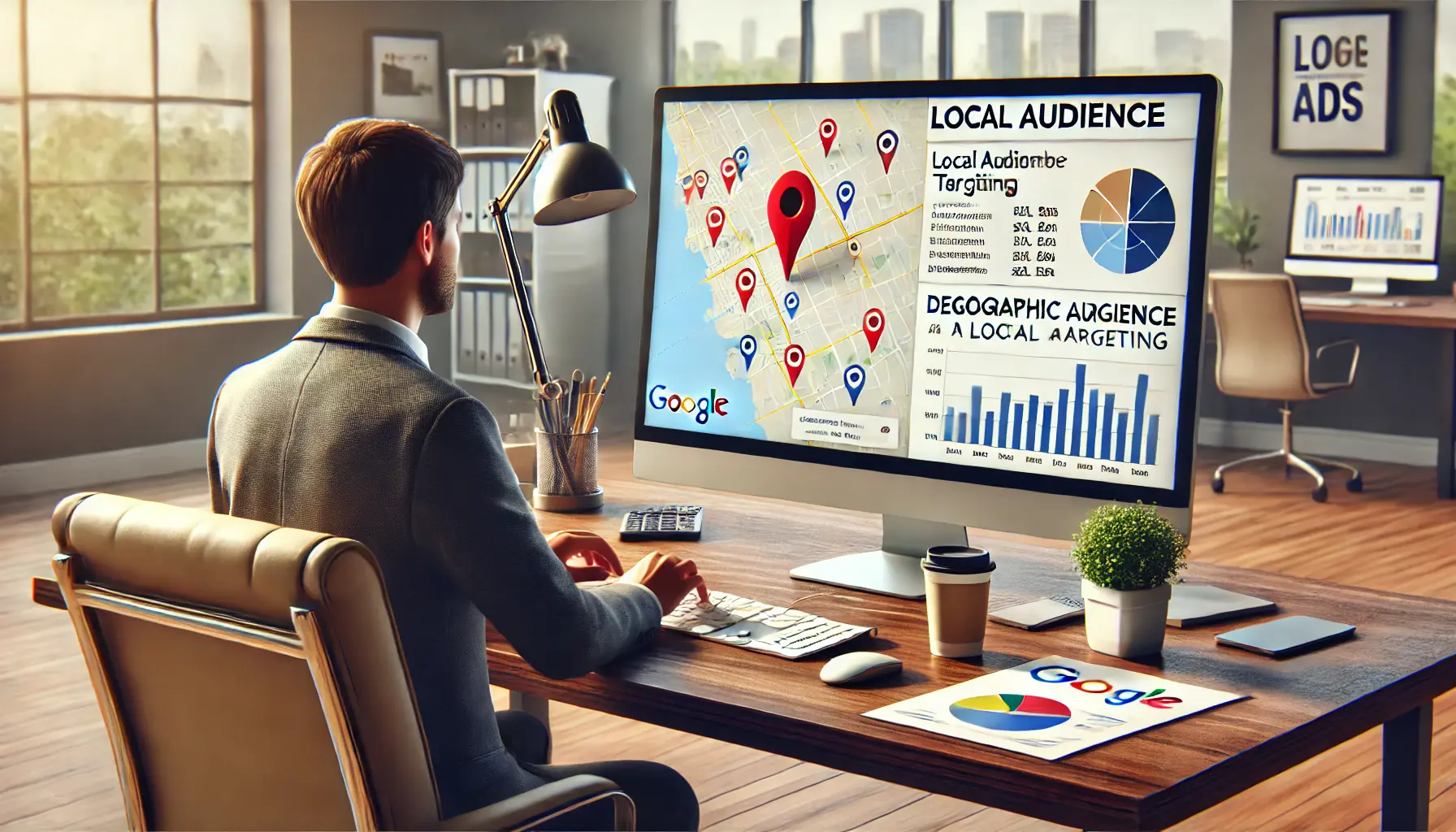
Illustration depicting a small business owner analyzing location and demographic data to target their local audience with Google Ads.
Targeting Your Local Audience Effectively
Precise targeting ensures your ads reach potential customers in your vicinity:
- Location Targeting: Define the geographic areas where your ads will appear. You can target by country, city, or a specific radius around your business. For instance, if you operate in Mersin, Türkiye, you might set a radius targeting of 20 kilometers to reach nearby customers.
- Demographic Targeting: Refine your audience based on age, gender, household income, and other demographics to reach those most likely to engage with your business.
- Device Targeting: Customize your ads for different devices, such as mobile phones, tablets, or desktops, to optimize user experience and engagement.
Implementing these targeting strategies helps ensure your ads are seen by the right people at the right time, enhancing the effectiveness of your campaigns.

Illustration showing a small business owner managing their budget for local Google Ads campaigns, emphasizing financial planning.
Budgeting for Local Ad Campaigns
Effective budgeting is key to maximizing your return on investment:
- Set a Daily Budget: Determine how much you’re willing to spend each day. Start with a small amount and adjust based on performance.
- Choose the Right Bid Strategy: Select a bid strategy aligned with your goals, such as maximizing clicks or achieving a target cost per acquisition (CPA).
- Monitor and Adjust: Regularly review your campaign performance and adjust budgets and bids to optimize results.
Flexibility is essential.
As you gather data on what works best, you can reallocate funds to the most effective campaigns and strategies.

Illustration showing a small business owner adding ad extensions to a Google Ads campaign, enhancing visibility with key information.
Using Ad Extensions to Highlight Key Information
Ad extensions enhance your ads by providing additional information and increasing visibility:
- Location Extensions: Display your business address, map, and distance to your location, making it easier for customers to find you.
- Call Extensions: Add a phone number to your ad, allowing users to call you directly with a single tap.
- Sitelink Extensions: Include additional links to specific pages on your website, directing users to relevant content.
- Callout Extensions: Highlight unique offers or features, such as “Free Consultation” or “Open 24/7.”
Utilizing these extensions can improve your ad’s performance by making it more informative and engaging, ultimately driving more traffic to your business.
By thoughtfully setting up your Google Ads campaigns with these strategies, you position your local business for greater visibility and success in attracting and retaining customers.
A clear strategy tailored to your local business ensures that Google Ads campaigns deliver measurable and impactful results.
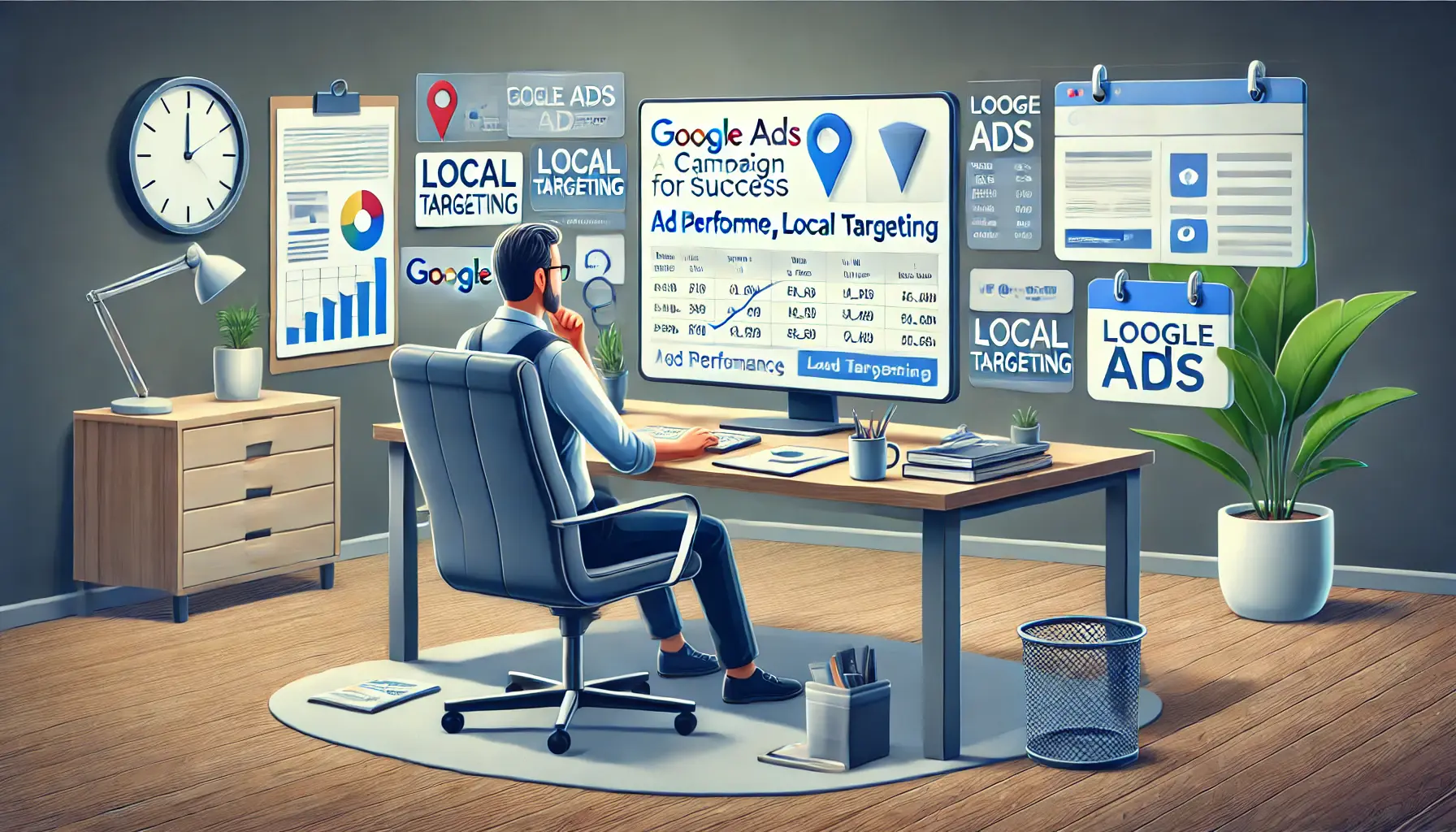
Illustration showing a small business owner working to create and optimize a successful local ad campaign for their business.
Creating Successful Local Ad Campaigns
Creating effective Google Ads campaigns targeting people close to your business is essential for boosting visibility and driving traffic.
By focusing on localized content and strategic optimization, you can improve ad performance and attract more customers.
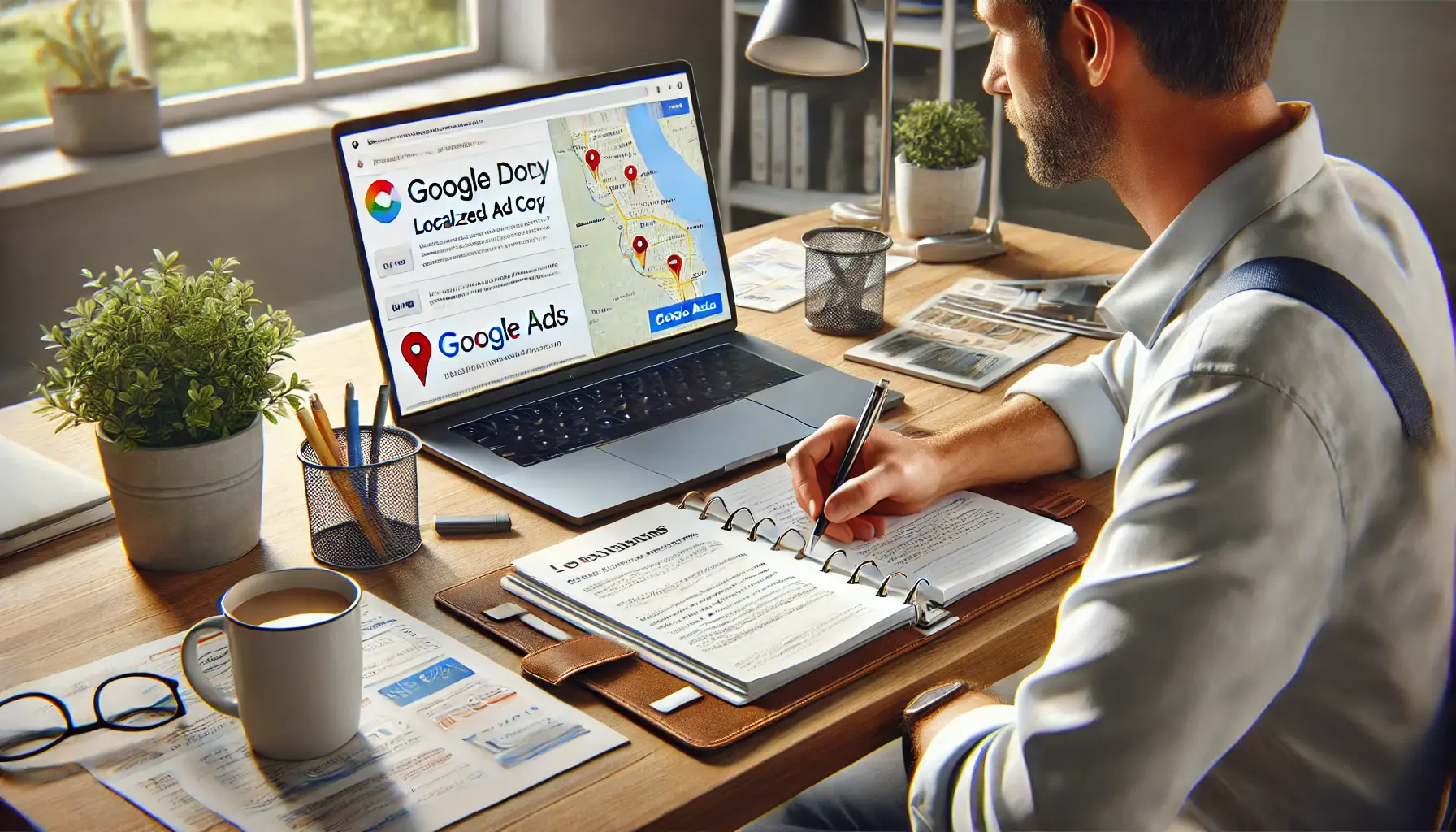
Illustration showing a small business owner creating localized and engaging ad copy for their Google Ads campaign, with a focus on community-targeted messaging.
Localized and Engaging Ad Copy
To resonate with your local audience, tailor your ad copy to reflect the uniqueness of your community:
- Include Local Keywords: Localize your terms with neighborhood names or local landmarks to increase relevance.
- Highlight Local Events: Mention community events relevant to your business to draw attention.
- Use a Conversational Tone: Be friendly and approachable to make a connection with your audience.
Personalizing your ad copy is a solid way to establish a stronger connection with potential customers near your business.

Illustration showing a small business owner researching and selecting keywords relevant to their area for a Google Ads campaign.
Keywords Relevant to Your Area
Effective keyword selection is critical for running successful local ads.
Using the wrong keywords can be costly, so follow these tips:
- Conduct Local Keyword Research: Use tools like Google’s Keyword Planner to identify popular search terms in your area.
- Focus on Long-Tail Keywords: Target phrases that include specific locations or services, such as “Best coffee shop in Mersin.”
- Monitor Competitor Keywords: Analyze competitors’ ads to discover additional keyword opportunities.
By targeting area-specific keywords, you can improve the visibility of your ad among local searchers.
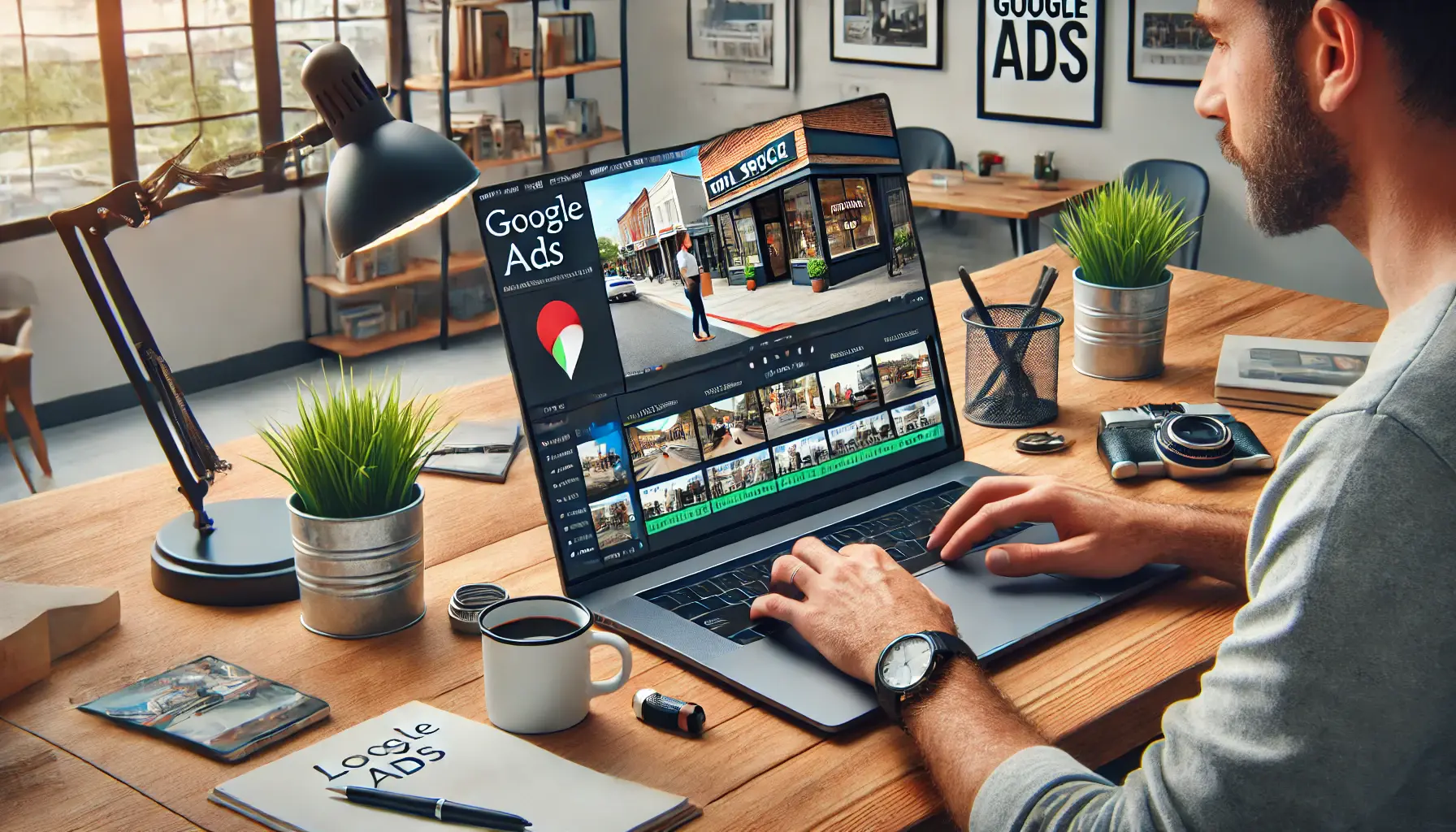
Illustration showing a small business owner working on location-specific content, such as images and videos, for a Google Ads campaign.
Location-Specific Images or Videos
Visual content can make a significant difference in your ads.
Here’s how to utilize it effectively:
- Use Local Imagery: Provide photos or videos of your location, staff, or local landmarks for familiarity.
- Showcase Customer Experiences: Include testimonials or footage of customers using your products or services.
- Keep Quality High: Use clear and professional visuals to maintain a positive brand image.
Including local visuals can make your ads more relevant and appealing to your target audience.

Illustration showing a small business owner conducting A/B testing to compare two ad versions and maximize campaign performance.
A/B Testing Ads to Maximize Performance
Testing different ad variations is essential to identify what resonates best with your target audience.
Here are some best practices:
- Create Multiple Ad Versions: Develop at least two versions of ads, varying headlines or descriptions.
- Test Only One Element at a Time: Change a single element per test to accurately identify its impact.
- Analyze Performance Metrics: Monitor click-through rates, conversions, and other indicators to measure effectiveness.
Regular A/B testing allows for continuous improvement and optimization of your ad campaigns.

Illustration showing a small business owner engaging with local customers in a friendly, welcoming store environment.
Leveraging Call-to-Action Phrases for Local Customers
Effective call-to-action (CTA) phrases can drive customer engagement.
Here are some tips:
- Use Clear and Direct Language: Phrases like “Visit us today” or “Call now” encourage immediate action.
- Highlight Local Benefits: Emphasize proximity or local advantages, such as “Just around the corner” or “Serving Mersin residents.”
- Create a Sense of Urgency: Use time-sensitive offers, like “Limited-time discount” or “Offer ends soon.”
Strategic CTAs encourage potential customers to take the next step toward engaging with your business.
Personalized, localized ad content and strategic optimization are key to connecting with your local audience effectively.

Illustration showing a small business owner reviewing metrics and optimizing their local Google Ads campaign for better performance.
Measuring and Optimizing Your Local Ad Campaigns
To ensure your Google Ads campaigns effectively reach your local audience, it’s essential to measure performance and make data-driven optimizations.
By focusing on key metrics and implementing strategic adjustments, you can enhance your campaign’s success.

Illustration showing a small business owner focused on monitoring key performance metrics to optimize their Google Ads campaign.
Key Metrics to Monitor
Tracking the right metrics provides insights into your campaign’s effectiveness:
- Click-Through Rate (CTR): Indicates how often people click on your ad after seeing it. A larger CTR suggests that your ad is relevant and engaging.
- Conversion Rate: Measures the percentage of clicks leading to a desired action, such as a purchase or sign-up. This reflects the effectiveness of your landing page and overall campaign.
- Cost Per Click (CPC): The average amount you pay for each click. Monitoring CPC helps manage your budget and assess the efficiency of your bidding strategy.
- Return on Ad Spend (ROAS): Estimates the revenue generated for every dollar spent on ads. A higher ROAS indicates a more profitable campaign.
Regularly reviewing these metrics allows you to identify areas for improvement and make informed decisions.

Illustration showing a small business owner analyzing local audience data and insights from Google Analytics to optimize their campaign.
Utilizing Google Analytics for Local Insights
Integrating Google Analytics with your Google Ads account provides deeper insights into user behavior:
- Track User Location: Understand where your website visitors are coming from to assess the effectiveness of your location targeting.
- Analyze User Behavior: Monitor how users interact with your site, including pages visited and time spent, to identify potential areas for optimization.
- Set Up Goals: Define specific actions, such as form submissions or calls, to measure conversions accurately.
Leveraging these insights helps tailor your campaigns to better meet the needs of your local audience.

Illustration showing a small business owner optimizing their Google Ads campaign by adjusting bids based on location performance data.
Adjusting Bids Based on Location Performance
Optimizing bids according to geographic performance can enhance your campaign’s efficiency:
- Identify High-Performing Areas: Use geographic reports to pinpoint locations with strong performance metrics.
- Increase Bids in Profitable Locations: Allocate more budget to areas yielding higher conversions to maximize returns.
- Reduce Bids in Underperforming Areas: Lower spending in regions with low performance to optimize budget allocation.
By adjusting bids based on location data, you can focus resources on areas that offer the greatest potential.
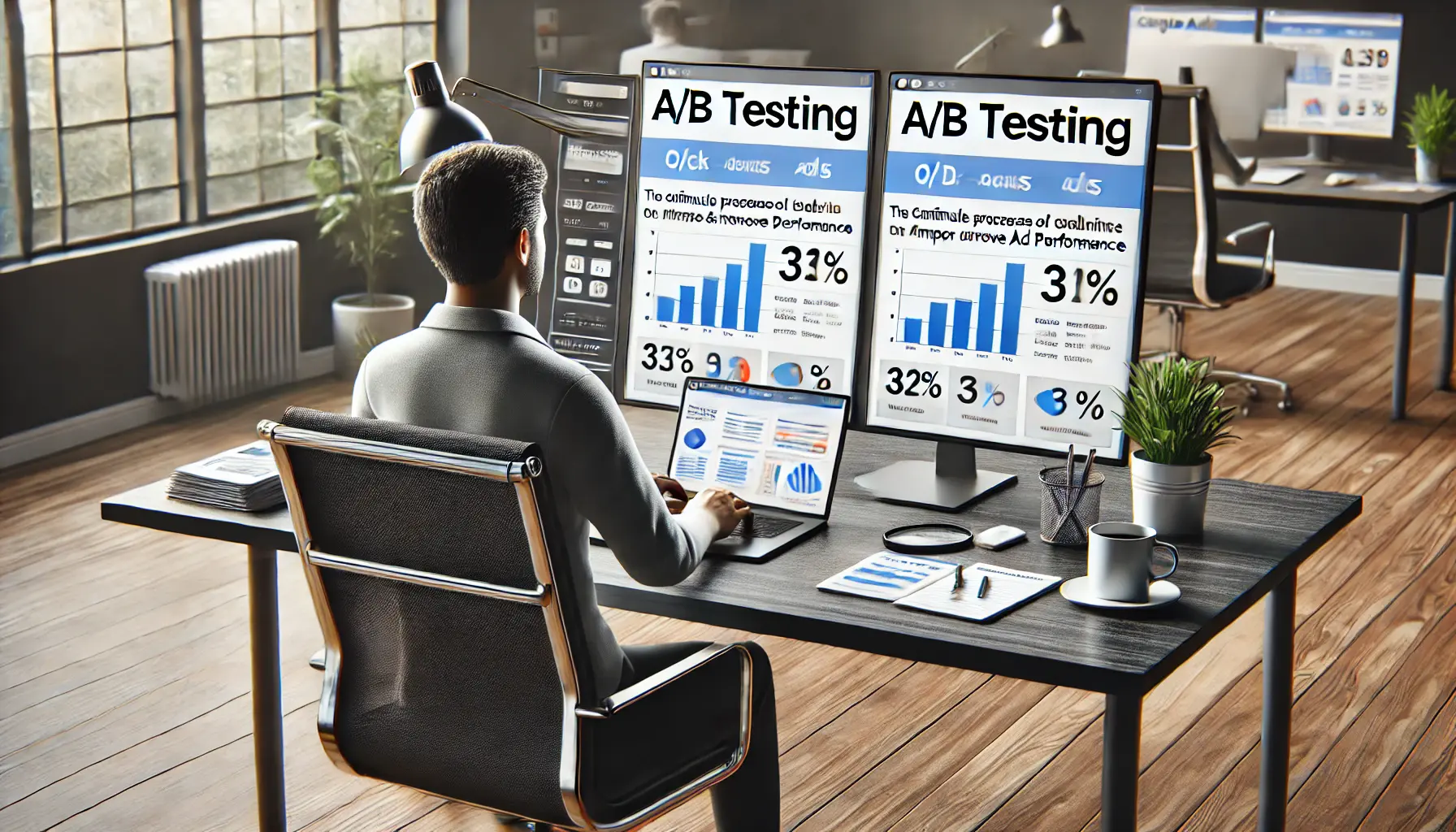
Illustration showing a small business owner conducting A/B testing to compare ad versions and improve campaign performance.
Implementing A/B Testing for Continuous Improvement
Regular testing of different ad elements helps refine your campaigns:
- Test Ad Copy Variations: Experiment with different headlines, descriptions, and calls-to-action to determine what resonates best with your audience.
- Evaluate Landing Pages: Assess the effectiveness of various landing page designs and content in driving conversions.
- Analyze Results: Use statistical significance to identify winning variations and implement changes accordingly.
Continuous A/B testing fosters ongoing optimization and improved campaign performance.

Illustration showing a small business owner adjusting audience targeting strategies based on demographic and interest data for a Google Ads campaign.
Refining Audience Targeting Strategies
Enhancing your audience targeting ensures your ads reach the most relevant users:
- Utilize Demographic Targeting: Focus on specific age groups, genders, or income levels that align with your customer base.
- Employ Interest Targeting: Reach users based on their interests and online behaviors to increase relevance.
- Leverage Remarketing: Re-engage users who have previously interacted with your site to encourage conversions.
Refining your targeting strategies helps deliver your ads to users most likely to engage with your business.
By diligently measuring performance and implementing these optimization techniques, you can enhance the effectiveness of your local ad campaigns and achieve better results.
Regularly review key metrics like CTRClick-Through Rate, a metric indicating the percentage of users who click on an ad after seeing it., conversion rates, and ROASReturn on Ad Spend, a metric that measures the revenue generated for every dollar spent on advertising. to refine and enhance campaign performance.
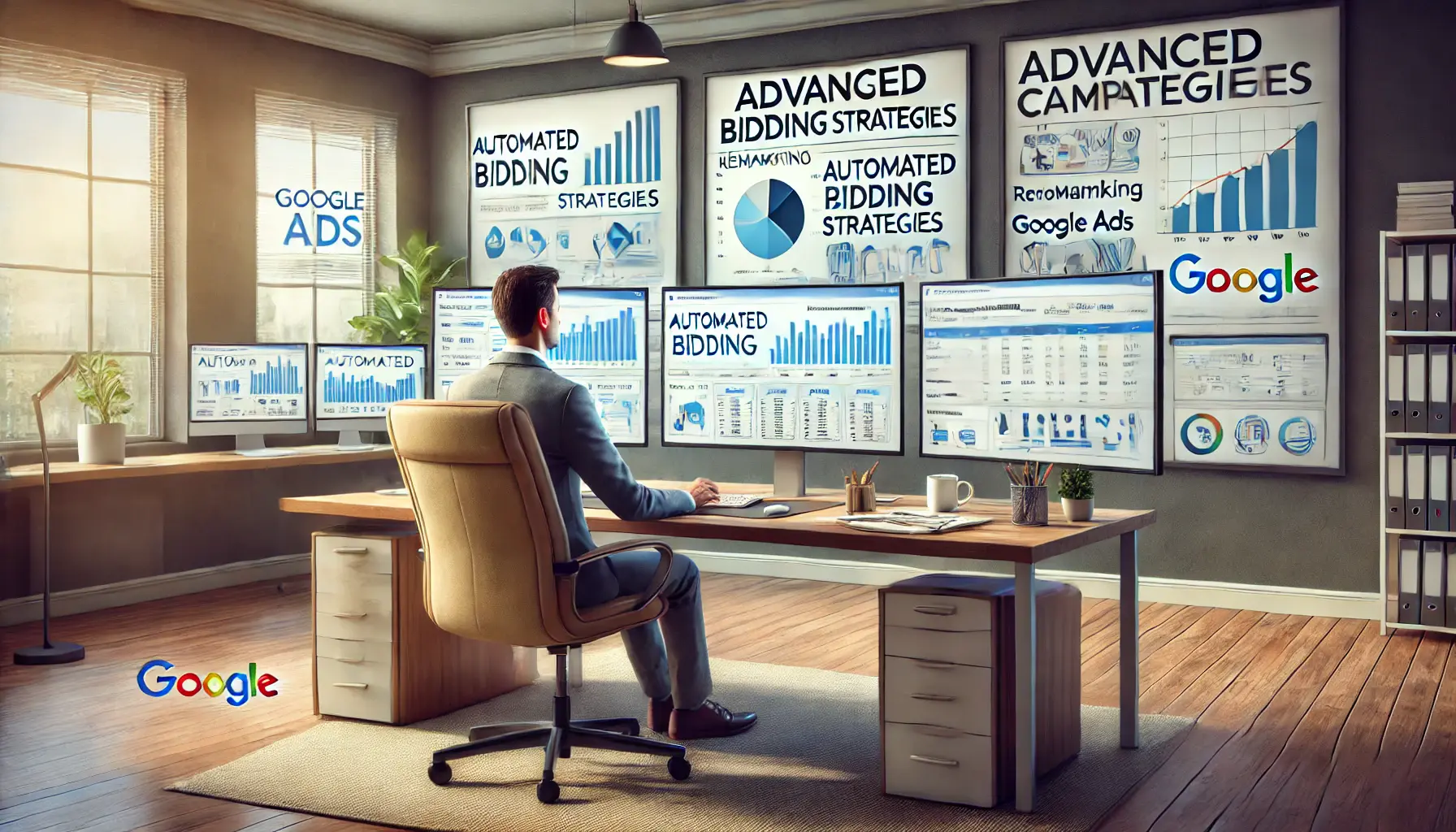
Illustration depicting a small business owner utilizing advanced strategies such as automated bidding and remarketing to optimize Google Ads campaigns.
Advanced Strategies for Local Business Google Ads
Elevating your local business’s online presence through Google Ads requires more than just the basics.
Implementing advanced strategies can significantly enhance your campaign’s effectiveness, ensuring you reach the right audience at the right time.
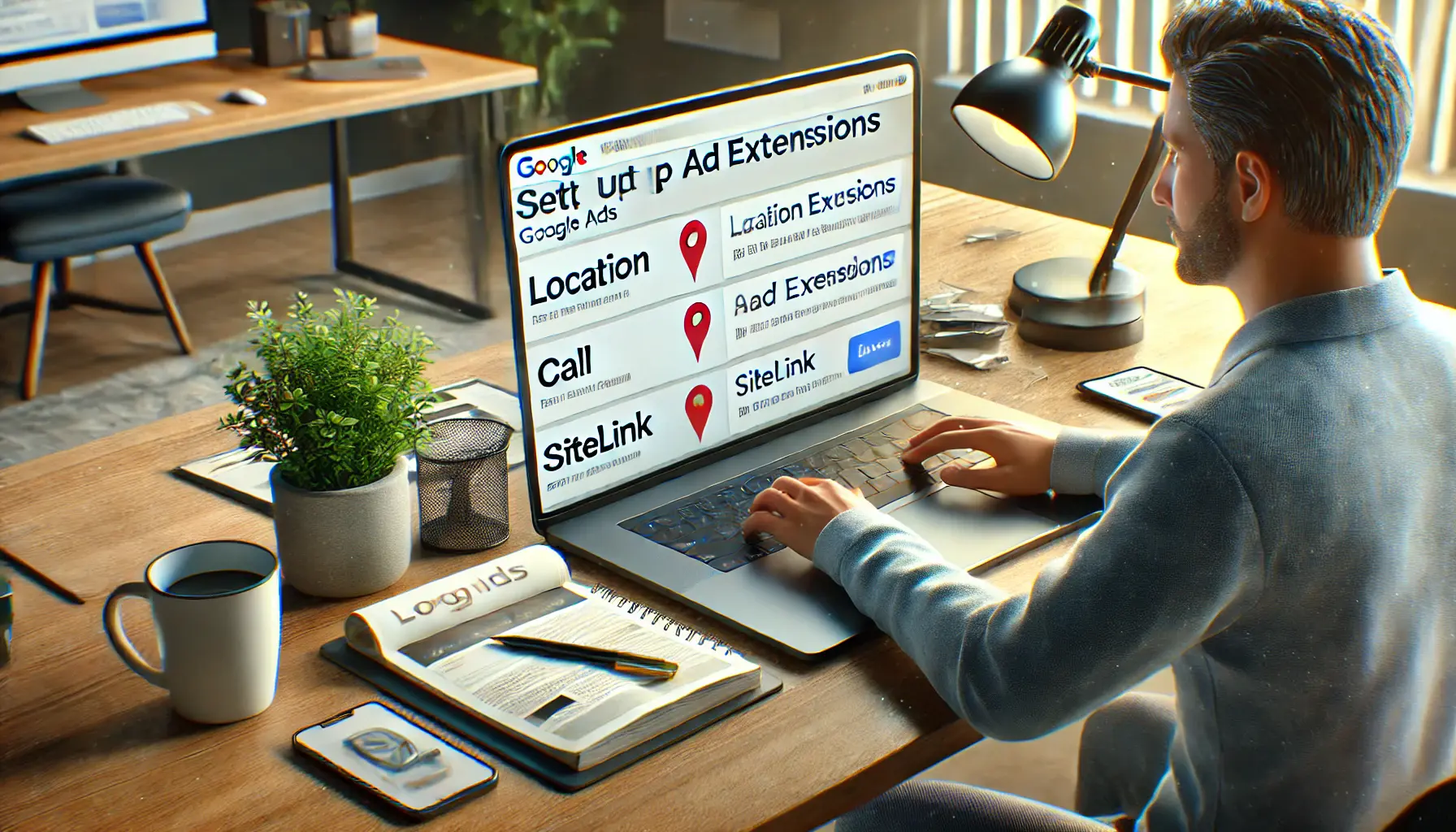
Illustration showing a small business owner using ad extensions to enhance the visibility of their Google Ads campaign.
Leveraging Ad Extensions for Enhanced Visibility
Ad extensions provide additional information and increase the visibility of your ads.
Types of extensions include:
- Sitelink Extensions: Direct users to specific pages on your website, such as ‘Services’ or ‘Contact Us.’
- Call Extensions: Allow users to call your business directly from the ad, ideal for mobile users.
- Location Extensions: Display your business address, encouraging local visits.
- Structured Snippet Extensions: Highlight specific aspects of your products or services.
Utilizing these extensions can improve your ad’s performance by making it more informative and engaging, ultimately driving more traffic to your business.

Illustration showing a small business owner using remarketing to target users who have previously interacted with their website.
Implementing Remarketing Campaigns
Remarketing allows you to show ads to people who have previously visited your website.
This approach keeps your brand top-of-mind and encourages conversions.
By targeting users who have already shown interest, you increase the likelihood of driving them back to complete a desired action.
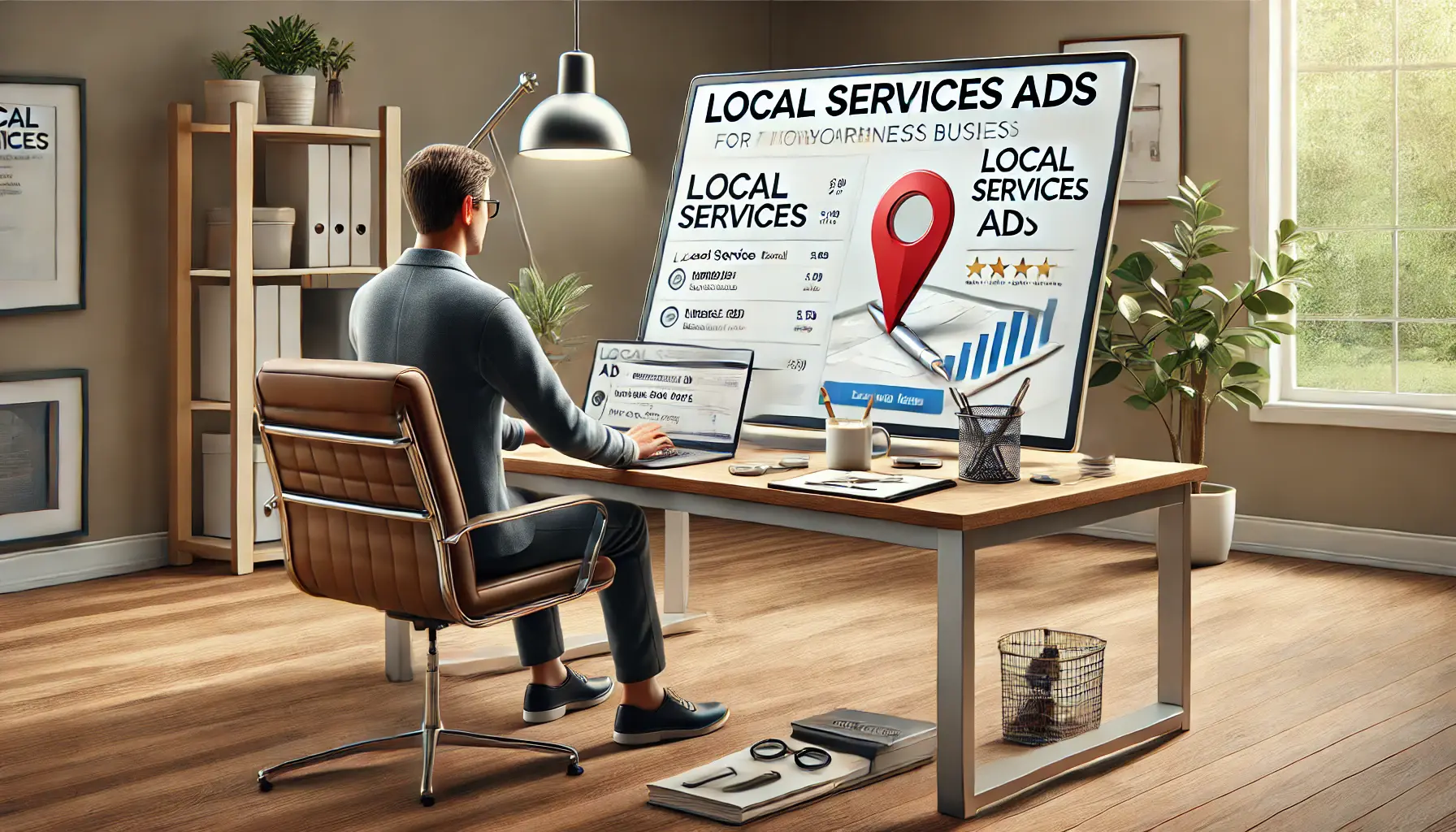
Illustration showing a small business owner using Local Services Ads to target local customers and analyze service leads.
Utilizing Local Services Ads
For service-based small businesses, Local Services Ads can be highly effective.
These ads appear at the top of Google search results and are designed to connect local service providers with nearby customers.
They operate on a pay-per-leadAn advertising model where businesses pay only for genuine leads generated through ads. model, ensuring you only pay for genuine leads, maximizing your return on investment.
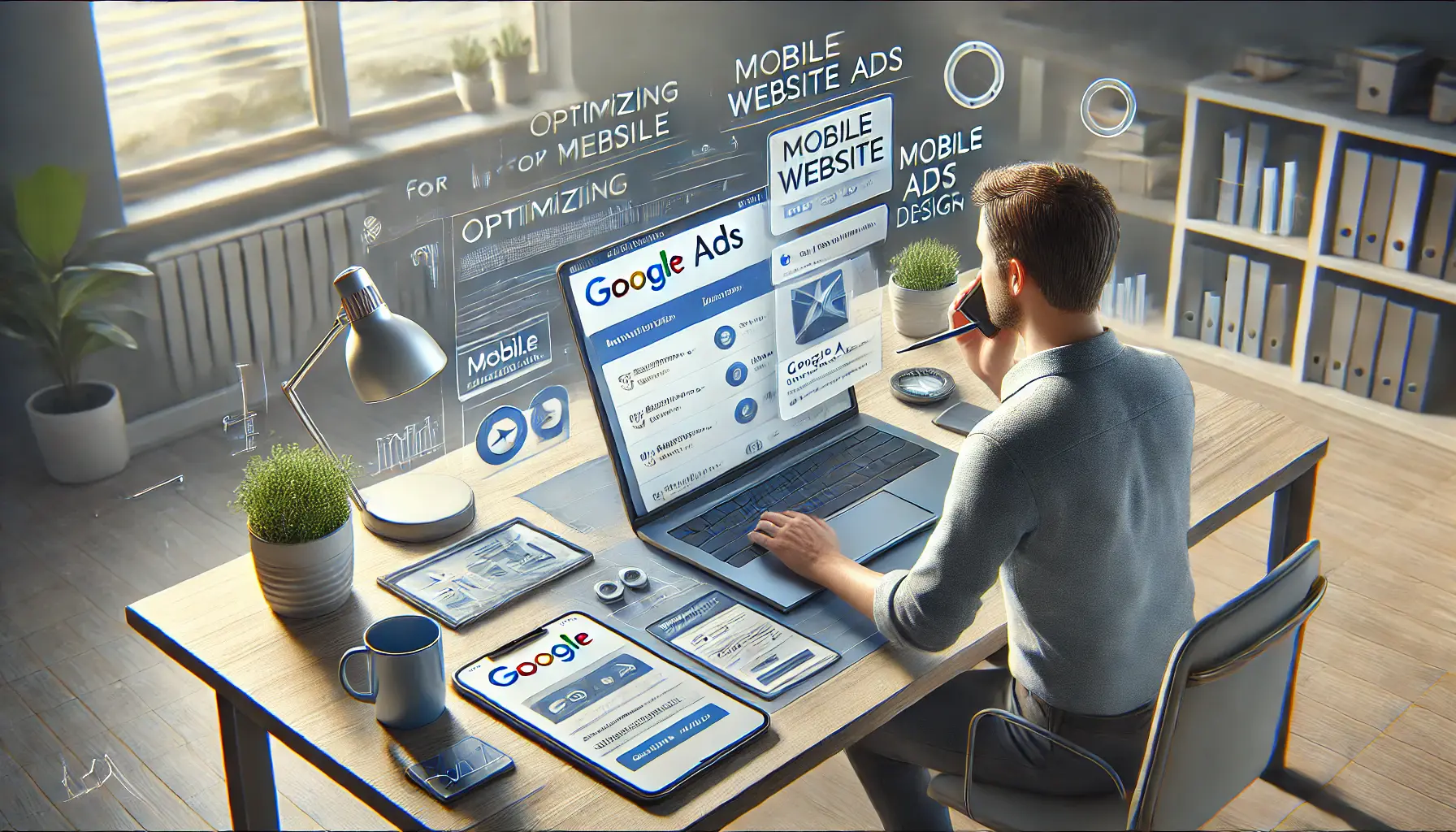
Illustration showing a small business owner working on a laptop to optimize their website and ads for mobile users.
Optimizing for Mobile Users
With the increasing use of mobile devices, ensuring your ads and landing pages are mobile-friendlyA design or content that is optimized for viewing and interaction on mobile devices. is critical to capturing this growing audience.
Mobile optimization includes fast-loading pages, easy navigation, and click-to-call buttons, all of which enhance the user experience and boost conversions.

Illustration showing a small business owner integrating AI and automation into their Google Ads campaign for better performance.
Integrating AI and Automation
Using AI and automation in Google Ads optimizes the ad targeting and bidding processes through advanced technology.
Features like automated bidding strategies and responsive search adsA Google Ads format that automatically tests different combinations of headlines and descriptions to optimize ad performance. align with user behavior in real-time, improving overall performance.
By incorporating these advanced strategies into your Google Ads campaigns, your local business will gain increased visibility, engage effectively with potential customers, and ensure higher conversions.
Incorporate advanced strategies like remarketingA strategy in Google Ads that targets users who have previously interacted with your website or app., mobile optimization, and AI-driven tools to stay competitive and drive higher engagement.
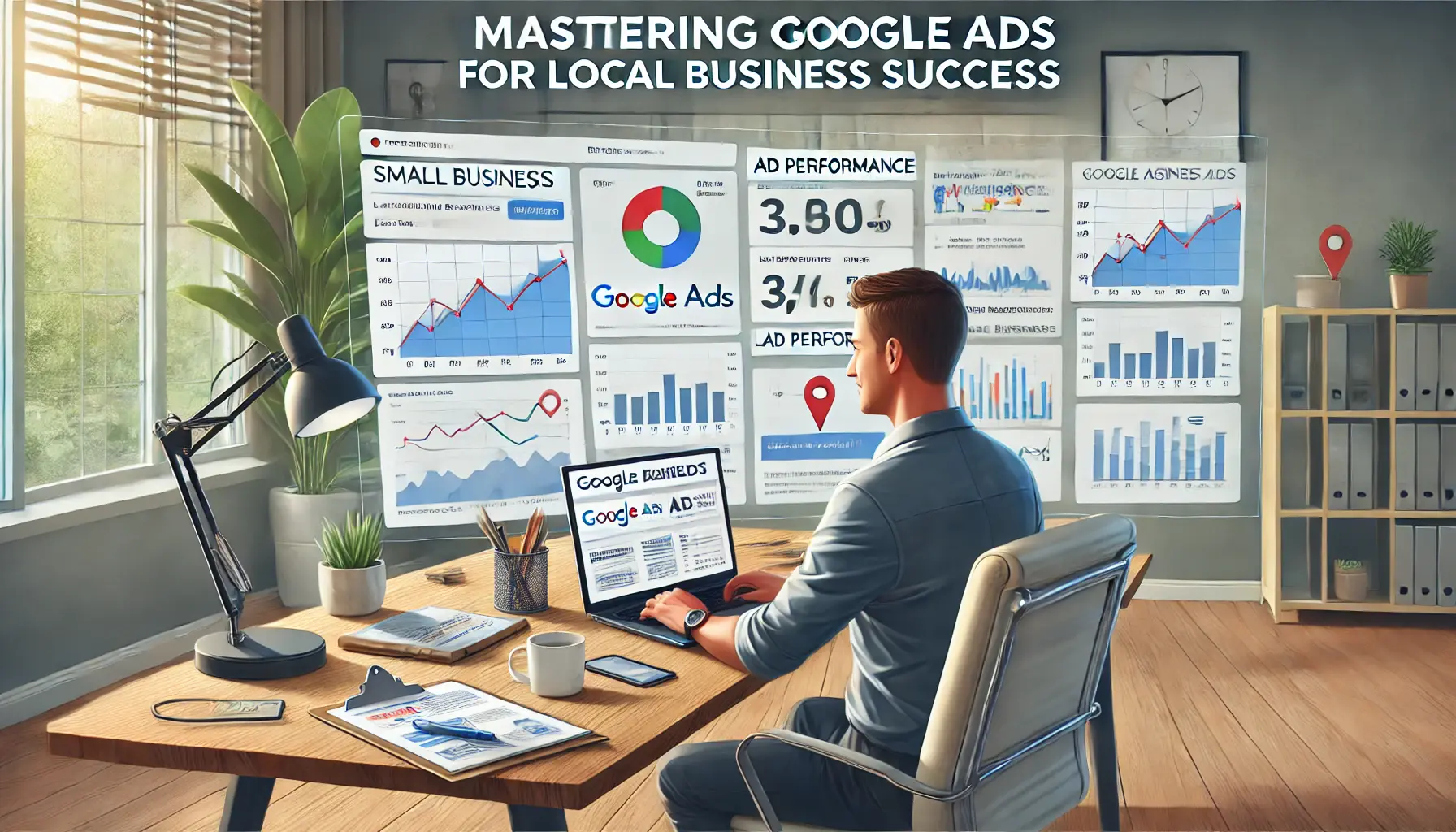
Illustration showing a small business owner mastering Google Ads to achieve local business success, with performance metrics and local data visible on the laptop screen.
Mastering Google Ads for Local Business Success
Google Ads has immense potential to aid local businesses in strengthening their online presence and connecting with customers in their vicinity.
By following the tips in this guide, you’ll be able to unlock the full potential of Google Ads and ensure meaningful results for your business.
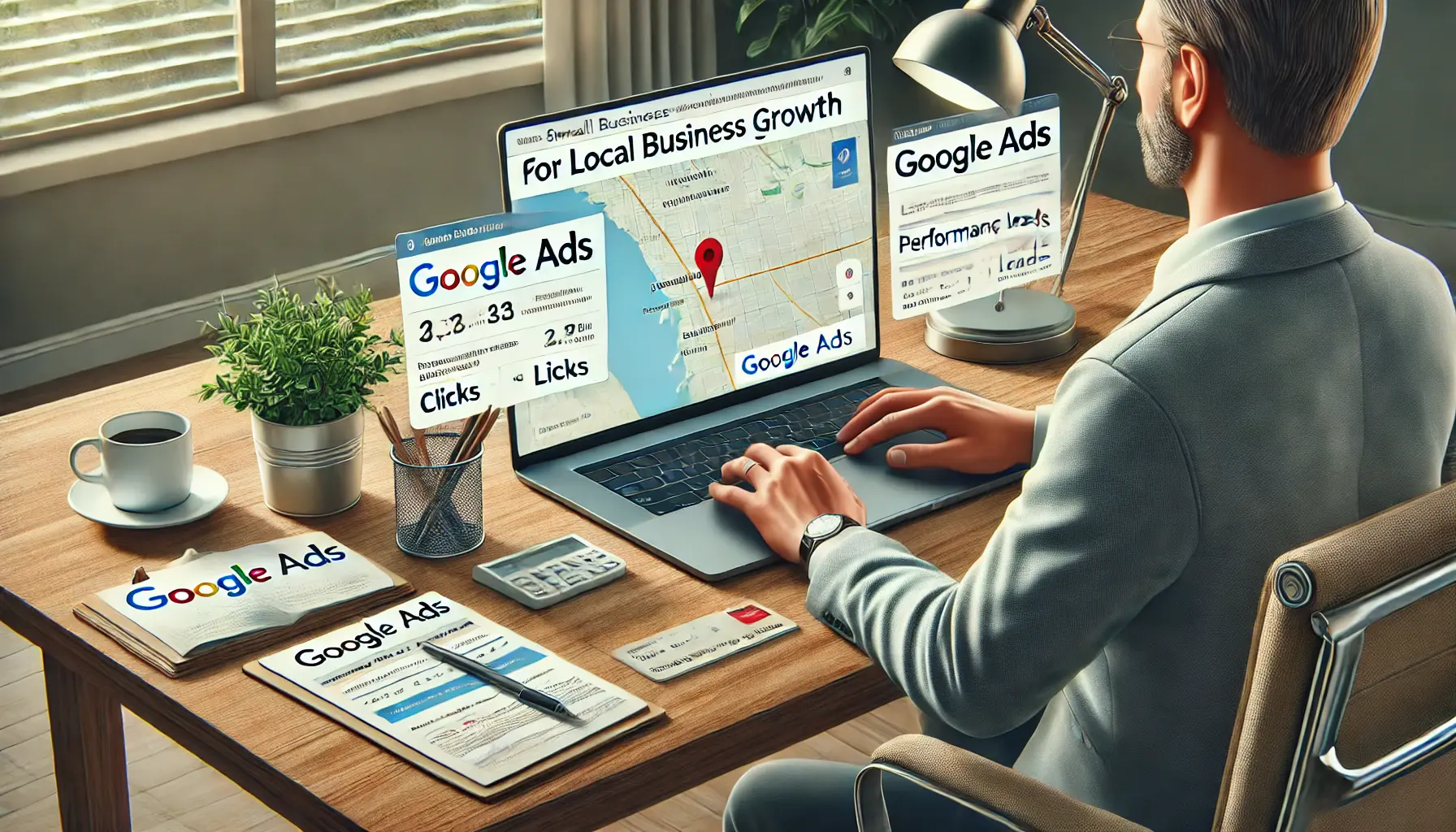
Illustration showing a small business owner evaluating the role of Google Ads in enhancing local business visibility and performance.
Why Google Ads is Crucial for Local Businesses
Google Ads equips local businesses with tools to effectively reach their audience.
From leveraging location-based targeting to utilizing advanced ad formats, the platform ensures your business remains visible when customers need your services the most.

Illustration showing a small business owner analyzing campaign setup and planning strategy to build a strong foundation for their Google Ads campaign.
Building a Strong Foundation
To succeed with Google Ads, start by setting up your campaigns correctly.
Select the right campaign type, such as Local Campaigns, and ensure your targeting aligns with your business objectives.
Use ad extensions and location-based keywords to increase visibility and relevance.
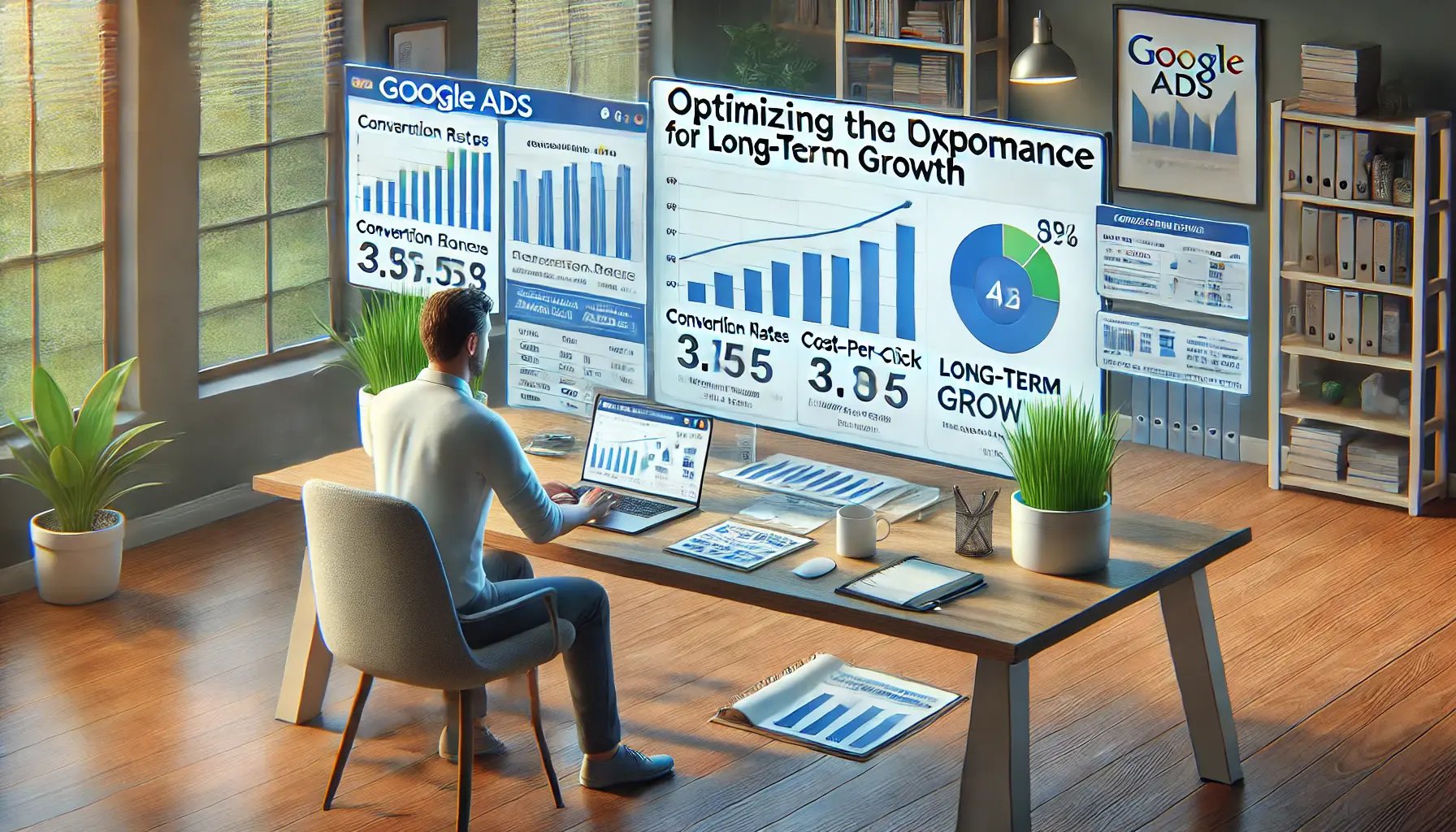
Illustration showing a small business owner analyzing Google Ads performance data, with a focus on optimizing for sustained long-term growth.
Optimizing Performance for Long-Term Growth
Measuring and optimizing your ad campaigns is key to achieving consistent growth.
Regularly monitor key metrics like CTR, conversion rates, and ROAS to identify areas of improvement.
Conduct A/B testing and refine your targeting strategies to maintain an edge over competitors.
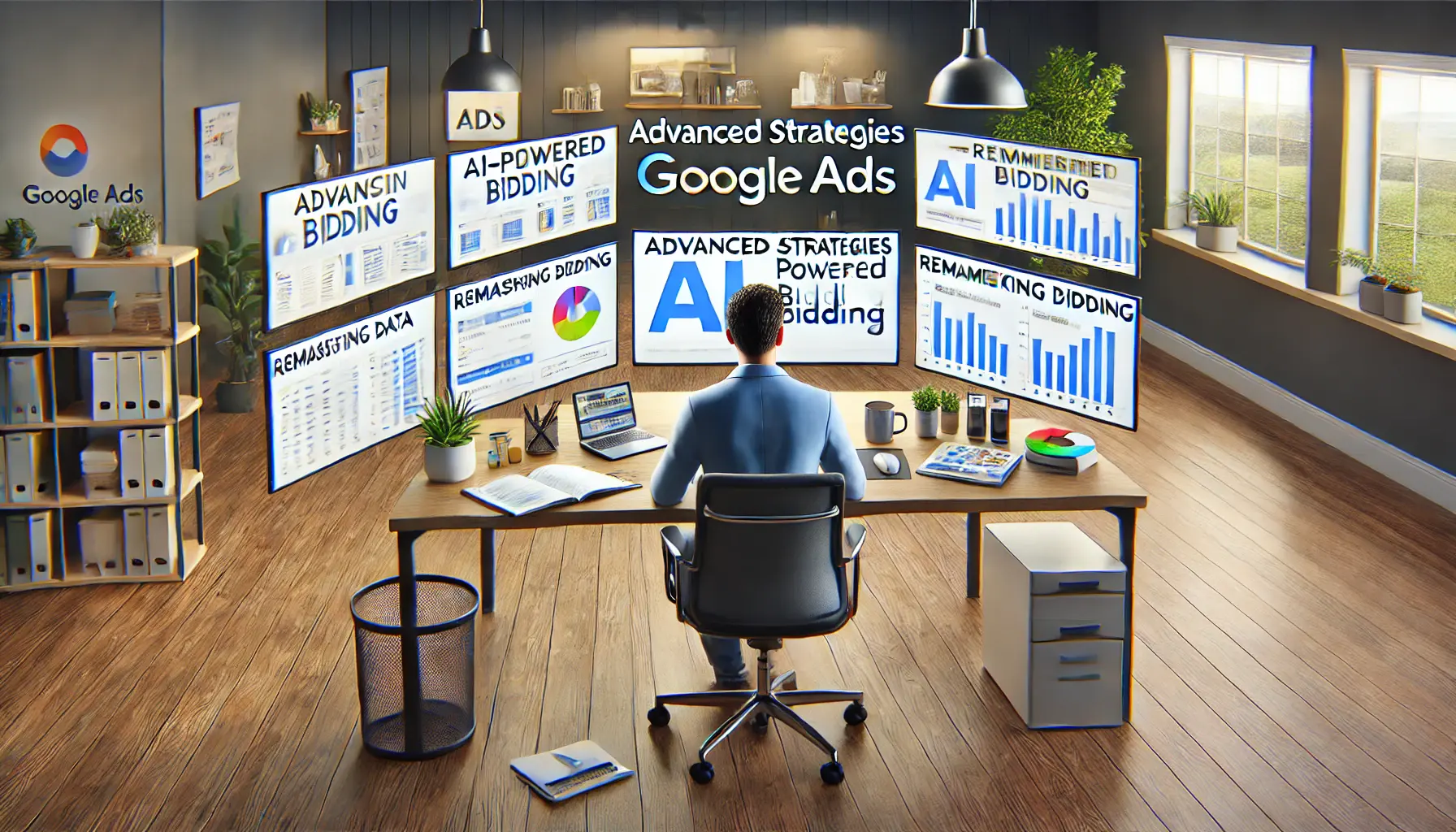
Illustration showing a small business owner using advanced strategies like AI-powered bidding and remarketing to enhance their Google Ads campaign impact.
Advanced Strategies for Greater Impact
Adopt advanced strategies to enhance the effectiveness of your campaigns.
Utilize remarketing to re-engage potential customers, optimize ads for mobile users, and incorporate AI-powered tools to automate processes and improve results.
Integrating these techniques ensures your Google Ads campaigns remain competitive and impactful.
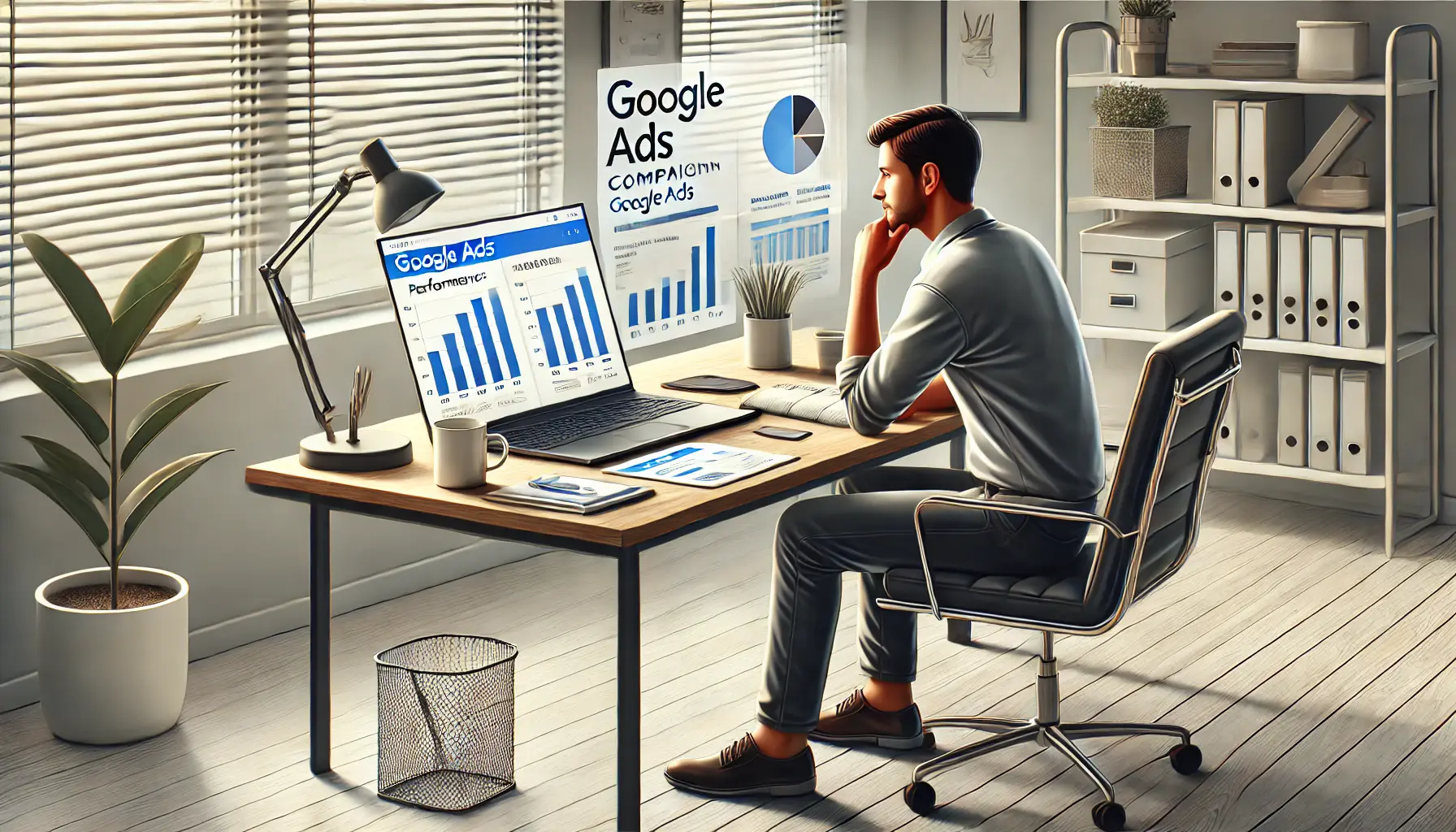
Illustration showing a small business owner feeling satisfied with the results of their Google Ads campaign, reviewing the final performance reports.
Conclusion
By combining foundational strategies with advanced techniques, local businesses can unlock the full potential of Google Ads.
Whether you aim to increase foot traffic, generate leads, or build brand awareness, Google Ads provides the tools and insights necessary to achieve your goals.
With continuous optimization and a focus on your local audience, your business can thrive in today’s competitive digital landscape.
Combining foundational strategies with advanced techniques ensures long-term growth and a solid online presence for local businesses.

Illustration showing a small business owner seeking guidance on Google Ads for local businesses, discussing strategies with a consultant.
Your campaigns can be managed by an agency specialized in Google Ads, check out our service page.
Frequently Asked Questions About Google Ads for Local Businesses
Addressing common inquiries can help local businesses effectively utilize Google Ads to enhance their online presence and attract more customers.
Google Ads is an online advertising platform that allows businesses to display ads on Google’s search engine and its advertising network, reaching potential customers actively searching for related products or services.
Google Ads lets local businesses decide their geographic targeting so that their ads appear to potential customers nearby.
This increases visibility, drives more traffic, and boosts sales.
Location targeting enables your ads to appear to people in specific geographic areas, from the country level to individual cities or regions, ensuring your ad displays to the most relevant local audience.
Google Ads offers flexible budgeting options.
Businesses can set daily or monthly budgets, control spending, and adjust based on campaign performance and goals.
Ad extensions are additional pieces of information, such as phone numbers or addresses, that enhance ads, making them more informative and increasing click-through rates.
Success can be measured by tracking key metrics like click-through rates, conversion rates, and return on ad spend, providing insights into campaign effectiveness.
Remarketing involves targeting ads to users who have previously visited your website, encouraging them to return and complete desired actions, such as making a purchase.
Ensure ads and landing pages are mobile-friendly, use responsive design, and consider mobile-specific ad formats to provide a seamless experience for mobile users.
Local Services Ads connect local service providers with nearby customers searching for specific services.
They appear at the top of Google search results and operate on a pay-per-lead model.



